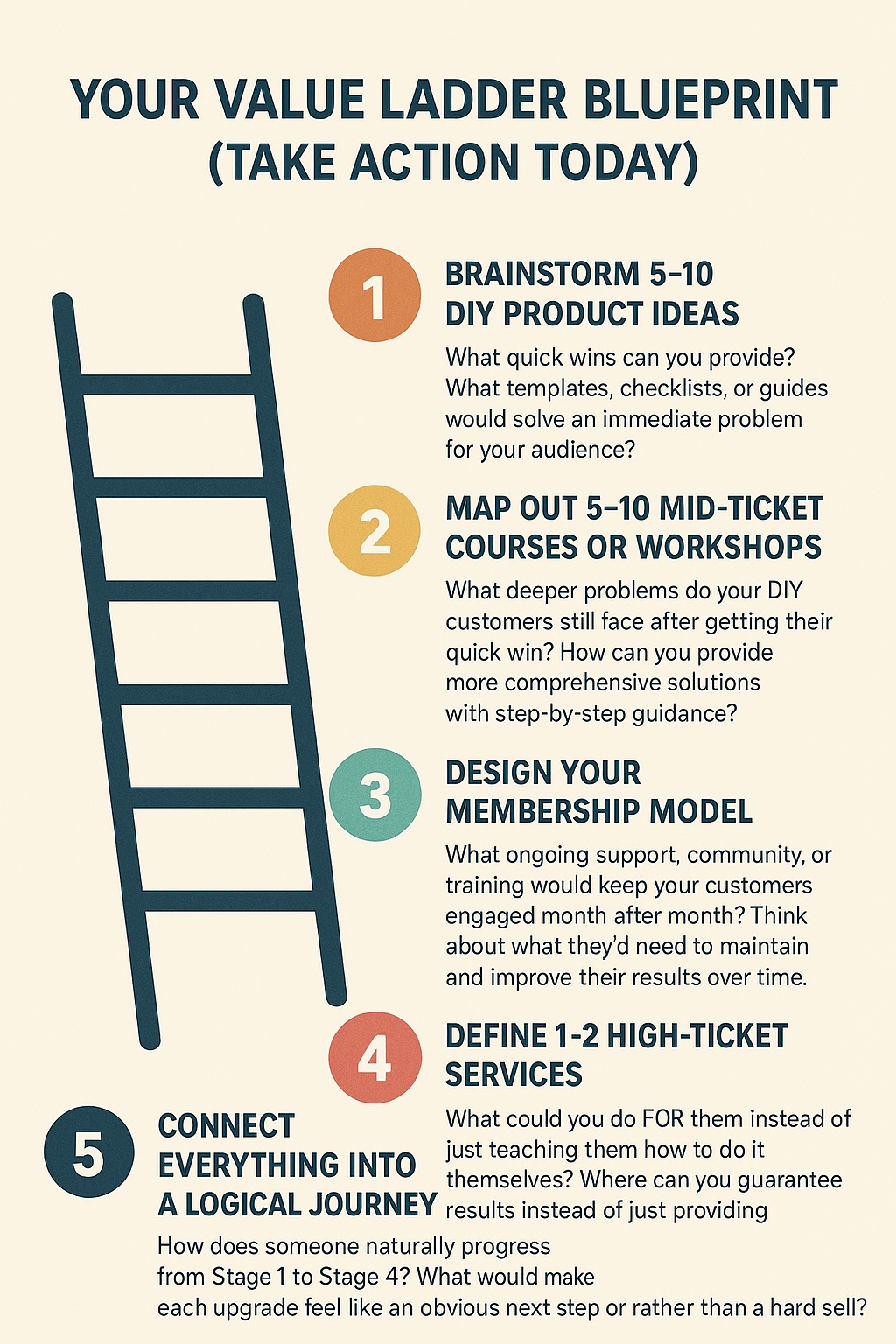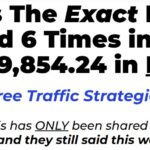Let me be brutally honest with you: selling $7-$20 digital products feels amazing at first. You see those PayPal notifications rolling in, and you think you’ve cracked the code. But here’s the harsh reality: low-ticket sales alone will never get you to life-changing income.
I’ve seen thousands of entrepreneurs stuck in this trap. They’re making a few hundred dollars a month, maybe even a few thousand, but they hit a ceiling that feels impossible to break through. They’re working harder, creating more products, posting more content, but their income stays frustratingly flat.
The problem isn’t your products. The problem isn’t your marketing. The problem is that you’re thinking about business all wrong.
Today, I’m going to show you exactly how to transform that $7 digital product into a $17,000/month business using something called a value ladder. This isn’t theory; this is the exact system that’s generated millions in revenue for my clients and students.
What is a Value Ladder (And Why You Need One Yesterday)
A value ladder is a strategic way of structuring your offers so customers naturally move from low-ticket to high-ticket purchases. Think of it like a staircase where each step represents a higher level of value and investment.
Here’s why this matters more than anything else you’ll learn about business:
First, acquiring new customers is expensive and exhausting. Whether you’re running ads, creating content, or building partnerships, getting someone to make their first purchase costs you time, energy, and often money. Once someone becomes a buyer, they’re 5-10 times more likely to buy from you again.
Second, serving existing customers with higher-value offers is significantly more profitable. You’ve already built trust, proven your competence, and established a relationship. The hardest part is done.
Third, a value ladder builds long-term customer lifetime value. Instead of making $20 per customer, you can make $200, $2,000, or even $20,000 per customer over time.
Why a Value Ladder Makes You More Money (The Psychology Behind the Purchase)
Here’s something most entrepreneurs don’t understand about buyer psychology: the first purchase isn’t really about the product; it’s about overcoming skepticism and building trust.
When someone buys your $7 planner, they’re not just buying a planner. They’re testing you. They’re asking: “Is this person legitimate? Do they deliver what they promise? Can I trust them with more of my money?”
Once they get results (even small ones), something powerful happens. Success motivates them to invest in bigger solutions. They think, “If I got this much value for $7, imagine what I could get for $200.”
This is why smart entrepreneurs think of low-ticket products as the “front door” to their business. The real revenue, the revenue that creates freedom and impact, happens on the back end.

The 4 Stages of a Profitable Value Ladder
Let me walk you through the exact framework that’s generated millions in revenue across dozens of industries:
Stage 1: DIY Products (Low-Ticket) – $7-$50
These are your planners, workbooks, cheat sheets, guides, templates, and e-books. Their purpose isn’t to make you rich; it’s to give customers a quick win and build your buyer list.
The psychology here is simple: you’re proving you can help them solve a problem without requiring a massive commitment. You’re building trust one small victory at a time.
The drawback? Results are often slow, and customers may still feel stuck because they lack the knowledge or support to implement effectively. That’s not a bug; it’s a feature. It creates natural demand for your next offer.
Stage 2: Done-With-You Courses & Workshops (Mid-Ticket) – $100-$400
This is where you provide deeper support and step-by-step guidance. Think online courses, live workshops, multi-part training series, or small group coaching.
Here’s the key: you’re not selling this to cold traffic. You’re selling to people who already bought from you, know your teaching style, and trust your expertise. The conversion rates are dramatically higher because the relationship already exists.
Your messaging shifts from “I can help you” to “You’ve already seen what I can do with our first product together. Ready to go deeper?”
Stage 3: Memberships & Recurring Coaching (Ongoing Revenue) – $49-$500/month
This is where your business becomes predictable and scalable. Monthly coaching calls, exclusive communities, ongoing training, and continuous support create recurring revenue that compounds over time.
The beauty of this model is efficiency. You can serve many customers simultaneously while providing significantly more value than Stage 1 or 2. It’s also incredibly sticky; once someone experiences the community and ongoing support, they rarely leave.
Stage 4: Done-For-You Services & 1:1 Coaching (High-Ticket) – $1,000-$10,000+
This is where you provide the fastest results for clients and generate the highest profits for your business. Whether it’s agency services, custom solutions, or intensive personal coaching, you’re selling outcomes, not just information.
Here’s what most people miss: some customers will skip straight to this level if their pain is urgent enough. A business owner losing $10,000/month isn’t going to mess around with a $7 workbook. They want the fastest path to results, regardless of price.

The Math Behind the Magic
Let me show you how this works with real numbers:
Start with 10,000 people who see your content (through social media, ads, SEO, etc.)
- 1,000 buy your $7 product = $7,000
- 100 of those buyers purchase your $200 course = $20,000
- 20 of those join your $97/month membership = $1,940/month recurring
- 5 invest in your $3,000 high-ticket offer = $15,000
Total first-month revenue: $55,000 Recurring monthly revenue: $1,940 (and growing)
But here’s where it gets interesting. Month two, you don’t need 10,000 new people. Your existing buyers keep moving up the ladder, your membership revenue grows, and you only need to maintain traffic flow to keep the system running.
This is why businesses with value ladders scale exponentially while single-product businesses hit plateaus.
Why Some Clients Skip Steps (And That’s Perfectly Okay)
Pain level directly correlates with willingness to pay. Someone who’s been struggling with their problem for months or years, who’s tried everything, who’s losing money or opportunities every day they don’t solve it; they don’t want to climb a ladder. They want to jump straight to the top.
Beginners typically start with DIY products because they’re not sure if they even have the problem you solve. But frustrated veterans, people with urgent needs, and those who value time over money will pay premium prices for premium solutions.
Your job is to have options at every level, so you never lose a sale because someone wants more or less than what you’re currently offering.
Email Marketing: The Engine That Powers Everything
None of this works without a systematic way to stay in touch with your buyers and prospects. Email marketing isn’t just important to your value ladder; it IS your value ladder.
Here’s why email lists are the backbone of every successful value ladder:
You own your email list. Social media platforms can change algorithms, ban accounts, or disappear entirely. Your email list belongs to you forever.
It’s dramatically easier to sell to people who already know you. Cold prospects need extensive warming up. Email subscribers are already engaged.
You can “pull the lever” anytime you launch a new offer. Need to generate $10,000 this month? Send a sequence to your email list promoting your high-ticket service.
Pro tip: Focus on building a buyer’s list, not just a subscriber list. Someone who’s purchased from you once is infinitely more valuable than someone who just downloaded a free lead magnet.
Your Value Ladder Blueprint (Take Action Today)
Here’s your homework, and I mean that literally. Don’t just read this and move on. Your financial future depends on implementing what you’re learning right now.
Step 1: Brainstorm 5-10 DIY Product Ideas What quick wins can you provide? What templates, checklists, or guides would solve an immediate problem for your audience? Don’t overthink this; simple often works better than complex.
Step 2: Map Out 5-10 Mid-Ticket Courses or Workshops What deeper problems do your DIY customers still face after getting their quick win? How can you provide more comprehensive solutions with step-by-step guidance?
Step 3: Design Your Membership Model What ongoing support, community, or training would keep your customers engaged month after month? Think about what they’d need to maintain and improve their results over time.
Step 4: Define 1-2 High-Ticket Services What could you do FOR them instead of just teaching them how to do it themselves? Where can you guarantee results instead of just providing information?
Step 5: Connect Everything Into a Logical Journey How does someone naturally progress from Stage 1 to Stage 4? What would make each upgrade feel like an obvious next step rather than a hard sell?

The Truth About Scaling: Serve Deeper, Not Wider
Here’s the counterintuitive truth that separates millionaire entrepreneurs from everyone else: income growth comes from serving fewer people at a deeper level, not from serving more people at a surface level.
You don’t need 100,000 customers buying $7 products. You need 100 customers investing $2,000 each, or 10 customers investing $20,000 each.
The entrepreneur trying to serve everyone with cheap products works 80 hours a week and makes $5,000/month. The entrepreneur serving a specific audience with a complete value ladder works 40 hours a week and makes $50,000/month.
Which would you rather be?
Your Next $7 Sale Could Lead to $17K Months
Every expert was once a beginner. Every successful business started with a single customer. Every value ladder started with a single product.
But here’s what separates the entrepreneurs who build million-dollar businesses from those who stay stuck: they think systematically from day one.
They don’t just create a $7 product; they create the first step in a $20,000 customer journey. They don’t just make a sale; they start a relationship. They don’t just solve a problem; they become the go-to expert for an entire category of problems.
Your $7 digital product isn’t just a product. It’s the foundation of a business system that can generate $15,000/month or more.
But only if you build it right.
Start mapping your value ladder today. Your future customers, and your future bank account, will thank you for it.
Remember: The best time to plant a tree was 20 years ago. The second-best time is today. Stop overthinking, start building, and watch your single product transform into a complete business system that creates the freedom and impact you’ve been dreaming of.










